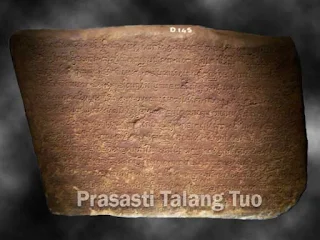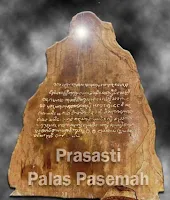Buddhist history in Sriwijaya Kingdom
History - In the beginning of the 6th century, the center of trade in Southeast Asia was Oc Eo, the capital of Fu-nan Kingdom in Cambodia. Fu-nan controlled the navigation lines in Southeast Asia in the 6th century.
Ships from India anchored at Kedah and unloaded there. The goods were then carried by caravans through Tanah Genting Kra. On Siam Bay, the goods were loaded on to ships again and transported to OC Eo. By so doing, the long, dangerous sea route could be shortened.
Merchant ships from India to Indonesia sailed along the west coast of Sumatra, went through Sunda Strait and stopped by in Tarumanegara. From there, they crossed by Java Sea, turned to Makasar Strait and stopped in Makasar, sailed to Kutai and went on to Philippines.
IN 539 AD, Khmer people who ruled Cambodia attacked Fu-nan from the north, and Fu-nan collapsed. Since Khmer people came from highlands, they did not prioritize trading by sea routes. So the trade in Oc Eo died.
In approximately 650 AD, Melayu or Malay (in Jambi region) appeared as a center of trade. This was not surprising because Melayu was located on the coast near Malacca Strait, while in front of it there were small islands that protected it, so Melayu became a good harbour for ships passing the strait.
In 683 AD, the kingdom of Sriwijaya was founded in Palembang which was equally strategic. It was rather far from the sea, but was connected by River Must which was good for navigation. Its location which was quite far inland. Sriwijaya suitable for merchant ships to anchor because it was protected from storms or pirates roaming the sea.
The name Sriwijaya was mentioned in Kedukan Bukit inscription which was written in 682 AD.
The foundation of Sriwijaya Kingdom
According to the study conducted by J.L. Moens, the capital of Sriwijaya was originally located in Kedah, then it was moved to the area at the meeting point of River Kampar Kanan and River Batang Hari at Muara Takus. At that place, there is a site of Sriwijaya remains in the from of Muara Takus Temple.
 |
| Muara Takus inscription |
From Muara Takus, a large number of Sriwijaya soldiers attacked Palembang and took it over. This was mentioned in the Kedukan Bukit inscription (682 AD). Kedukan Bukit was located on the side of river Talang near Palembang. The inscription was written in Pallava scripts using old Malay language. Some of the content was as follows.
"Dapunia Hyang set off from Minaga, taking along 20.000 soldiers and 200 boxes of supplies on boats, heading for a place called Melayu. On the 5th of Asadha (682 AD), they happily arrived in a place and built a town (Wanua) and Sriwijaya obtained victory, the expedition was succesful and the whole country prospered."
 |
| Kedukan Bukit inscription |
According to N.J. Krom, the event was the attack by Sriwijaya troops from Minanga (Minangkabau) to take over Palembang which was under the control of Melayu kingdom. Then Palembang was changed into the capital of Sriwijaya Kingdom.
The Talang Tuo inscription in the west of Palembang which was written in Pallava scripts (684 AD) told about the building of Sriksetra Park under the order of Punta Hyang Sri Joyanasa for the prosperity of all beings. In addition, it also contained some prayers and hopes which showed the characteristics of Buddhism.
 |
| Talang Tuo inscription |
The Telaga Batu inscription near Palembang was written in Pallava scripts and old Malay lenguage. It contained curses on anyone committing a crime and disobeying the king.
The conclusion which can be made from the three inscriptions is that after the king of Sriwijaya took over Palembang, the king tried to win the heart of the people in the accoupied territory by building a park which pleased the people. However, the tendency to oppose the king of Sriwijaya was detected, so the king issued a threat to anyone who dared to oppose the king and disobey his orders.
The Kota Kapur inscriptions which was found near the river Menduk in Bangka Island was dated 686 AD. The inscription contained curses saying that those who committed crime and those who disobeyed the king would receive misfortunes. The inscription also said that Sriwijaya would punish Bhumi Java that did not submit to Sriwijaya.
What was meant by Bhumi Java was Tarumanegara which was a competitor of Sriwijaya in trade. The Chinese news said further that from 666 to 669 AD Tarumanegara did not send any more messenger to China. This was because the seas around Tarumanegara were blockaded by Sriwijaya.
The Karang Brahi inscription found on the side of river Batang Hari in Jambi in 686 AD contained curses on those who dared to resist the king, like what was written in Kota Kapur inscriptions. The inscription was made after Sriwijaya conquered Melayu in 685 AD, as told by I-tsing.
The palas Pasemah inscription on the side of river Sekampung. Southern Lampung, was assumed to be made in the end of the 7th century. The content was the same as Kota Kapur inscription and Karang Brahi inscription, that is curses and remindings. So the region South Lampung was already controlled by Sriwijaya.
At Bukit Seguntang, some short inscriptions (fragments) have also been found. Some of the senteces say like this.
1. not knowing pira marvya (ha), meaning not knowing how many went to the war.
2. vanak pramirahna, meaning there was a lot of blood shed.
3. pauravirakta, meaning red (with blood).
4. mamancak yam praja, the meaning was not cleary known but it was assumed to relate to the war.
Next article : Expansion and diplomacy of Sriwijaya Kingdom
From the above inscriptions, it can be concluded that a severe war that caused a lot of deaths had happened.
 |
| Telaga Batu inscription |
 |
| Kota Kapur inscriptions |
What was meant by Bhumi Java was Tarumanegara which was a competitor of Sriwijaya in trade. The Chinese news said further that from 666 to 669 AD Tarumanegara did not send any more messenger to China. This was because the seas around Tarumanegara were blockaded by Sriwijaya.
 |
| Karang Brahi inscription |
The palas Pasemah inscription on the side of river Sekampung. Southern Lampung, was assumed to be made in the end of the 7th century. The content was the same as Kota Kapur inscription and Karang Brahi inscription, that is curses and remindings. So the region South Lampung was already controlled by Sriwijaya.
At Bukit Seguntang, some short inscriptions (fragments) have also been found. Some of the senteces say like this.
 |
| Bukit Seguntang inscription |
2. vanak pramirahna, meaning there was a lot of blood shed.
3. pauravirakta, meaning red (with blood).
4. mamancak yam praja, the meaning was not cleary known but it was assumed to relate to the war.
Next article : Expansion and diplomacy of Sriwijaya Kingdom
From the above inscriptions, it can be concluded that a severe war that caused a lot of deaths had happened.
